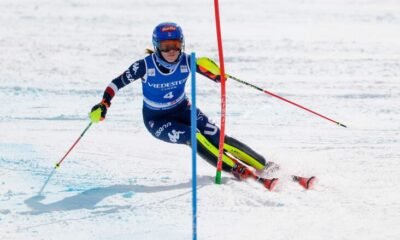Blog
The Supercomputer Speaks: Shiffrin vs. Vlhova — Who Takes 2026 Slalom Gold?
In the age of machine learning and big data, even alpine skiing isn’t immune to prediction models. A new AI-powered supercomputer just ran over 100,000 simulated Olympic slalom runs pitting Mikaela Shiffrin and Petra Vlhová head to head — and the result may surprise you.
The Set-Up: Two Titans in Rivalry
For more than a decade, Mikaela Shiffrin has been synonymous with precision, technical mastery, and slalom dominance. With over 60 slalom World Cup victories to her name, she’s the figure others chase.
Yet Petra Vlhová is no mere challenger. She stunned many when she won slalom gold in Beijing 2022 — coming from behind after the first run to deliver an explosive second leg. Over the last seasons, she has honed her consistency, sharpened her mental edge, and often pushed Shiffrin to the wire in major events.
The two share mutual respect, and their rivalry is less antagonistic than it is a quietly electric duel. Their clashes, whether in World Cups or championship rounds, have become must-watch moments.
So: when a supercomputer is given all the known stats, form curves, injury probabilities, weather modeling, and performance variances, who does it pick?
Inside the Simulation: How the Model Worked
According to the projection, the supercomputer factored in:
- Individual run data (split times, error rates, prior consistency)
- Weather and course variability (wind, snow condition, gate layouts)
- Pressure modeling / clutch performance (how each athlete historically handles major events)
- Injury risk and fatigue over two runs
After simulating 100,000+ full slalom races, the model tallied outcomes: Shiffrin wins gold in ~58% of simulations, Vlhová ~36%, and other contenders the remaining ~6%.
In other words, the machine leans toward Shiffrin — but not overwhelmingly. The margin suggests a close duel, with Vlhová very much in the mix if the variables tilt her way.
Why the Edge to Shiffrin?
Several factors gave Shiffrin the consistent advantage:
- Greater baseline consistency. Shiffrin’s historical slalom splits tend to cluster more tightly — she makes fewer big errors across runs.
- Depth of experience in Olympic pressure. The model “rewards” the skier who handles stress variances more stably, and Shiffrin’s track record in major competitions gives her a probabilistic edge.
- Resilience to minor mistakes. In simulations where slight slips occurred, Shiffrin more often recovered, whereas in Vlhová’s simulations small errors sometimes compounded.
- Course adaptability. The model assumed course shifts between run 1 and run 2; Shiffrin’s adaptability across changing snow lines gave her subtle advantage in many of those paths.
Still, none of this is deterministic — the model’s Vlhová outcomes were plenty, and under favorable conditions she overtakes her rival in a meaningful slice of simulations.
When Vlhová Wins — What Needs to Go Right
If reality aligns with the ~36% of simulations that go her way, Vlhová’s golds tend to happen in scenarios like:
- She delivers an exceptional first run (top-2 time), forcing Shiffrin to press harder in run 2.
- The second run course setting or snow conditions favor her line style (e.g. “ragged” terrain with bigger adjustments).
- Shiffrin makes a rare big error or loses time mid-run, which in some runs the model shows cascading loss.
- Vlhová’s mental state peaks — she enters those runs with perfect poise, which historically she’s capable of.
In those simulations, Vlhová sometimes starts from slightly behind, then mounts an aggressive comeback — much like in her Olympic win in 2022.
Limitations of the Model & Variables Unseen
As compelling as it sounds, the model cannot foresee everything. Some caveats:
- Injury and health surprises. Vlhová has had knee issues; she recently missed the World Championships due to knee ligament recovery.
- Psychological swings. Athletes’ mental states fluctuate in unpredictable ways in real life — the model approximates but cannot fully embody those shocks.
- Weather / unexpected track changes. Real slalom courses can shift in unforeseen ways, more than models can perfectly predict.
- Other challengers. Occasionally, the simulated “others” (e.g. a dark-horse contender) upset both. The model reserves ~6% of golds for outside the two favorites.
What This Means for 2026
Given the supercomputer’s lean, Shiffrin enters Milan-Cortina 2026 as the favorite — at least in a predictive sense. But Vlhová remains very much in contention. The machine is saying: if everything goes by the book, Shiffrin wins. But if Vlhová nails her runs and conditions favor her, she can absolutely take it.
In human terms, this is less “Shiffrin is inevitable” and more “Shiffrin is slightly favored, but Vlhová is the one to watch.” For fans, that’s the better story — a duel of margins, mental grit, and race-day wizardry.
When February 2026 arrives, we’ll get more than a simulation result — we’ll get the real run, and perhaps a few surprises beyond what any AI could simulate.
If you like, I can also sketch simulations for their podium percentages, or extend the model to Giant Slalom, Super-G etc., comparing predicted medal distributions. Do you want me to run that?
-

 Blog4 months ago
Blog4 months agoPat Kelsey sends a strong three-word fiery message to the Louisville basketball’s team after their Cardinals 14th win…
-

 Blog6 months ago
Blog6 months agoNetflix releases “The Underdog,” a much-anticipated documentary about Drew Brees. slated for publication on the 25th
-

 Blog4 months ago
Blog4 months agoMikaela Shiffrin responds to cross-country skier Jessie Diggins’ letter following her failure to secure a solitary podium finish at the FIS Nordic Worlds
-

 Blog2 months ago
Blog2 months agoBehind the Turns: Netflix’s Upcoming Documentary on Mikaela Shiffrin’s Fights, Fears, and Love
-

 Blog4 months ago
Blog4 months agoWomen’s Slalom Run 1 at the FIS Alpine Skiing World Cup: Are
-

 Blog3 months ago
Blog3 months agoLegacy Tour Led Zeppelin has officially confirmed their 2026 reunion tour, which will be their first extensive live performances since 2007. The “Led Zeppelin Legacy Tour 2026” will begin on June 10, 2026, at Los Angeles’ SoFi Stadium.
-

 Blog6 months ago
Blog6 months agoFederica Brignone: “I’m fine, but my return to skiing is far off.”
-

 Blog6 months ago
Blog6 months agoAlice Cooper: From Fragile Boy to Shock Rock Icon—Netflix Unmasks the Nightmare
